#54 Breaking the glass ceiling
The Life and Art of Mary Filer
by Christina Johnson-Dean, with an introduction by Robert Held
Salt Spring Island: Mother Tongue Publishers, 2016
$35.95 / 9781896949550
Reviewed by Janet Mary Nicol
First published Nov. 30, 2016
*
The Life and Art of Mary Filer follows the career of the glass sculptor Mary Filer. Trained as a painter, Filer joined the glass art movement in the 1960s and became its greatest practitioner on the west coast in the following decades. Reviewer Janet Nicol assesses the notable career and long life of this exceptional artist in glass — Ed.
*
 A pioneer in glass art, Mary Harris Filer was born in Edmonton in 1920 and passed away in 2016 in Vancouver, aged 95. The subject of the ninth book in Mother Tongue’s invaluable “Unheralded Artists of British Columbia” series, Christina Johnson-Dean reveals Filer as a remarkable Canadian artist whose glass sculptures were original, bold, and inspirational.
A pioneer in glass art, Mary Harris Filer was born in Edmonton in 1920 and passed away in 2016 in Vancouver, aged 95. The subject of the ninth book in Mother Tongue’s invaluable “Unheralded Artists of British Columbia” series, Christina Johnson-Dean reveals Filer as a remarkable Canadian artist whose glass sculptures were original, bold, and inspirational.

Johnson-Dean was given full access to Filer’s personal papers by the artist’s nephew, providing a crucial source for this rich visual and biographical account.
Interested in art from an early age, Filer trained to be a nurse in Regina, followed by post-graduate work in Montreal. “What have I done?” she reflected on her training. “I was horrified. It had gone against all my desires, all my talents, but there I was, stuck for three years.”
Deciding to return to her artistic urgings, Filer enrolled in fine arts at McGill University and then did graduate work in Pennsylvania.

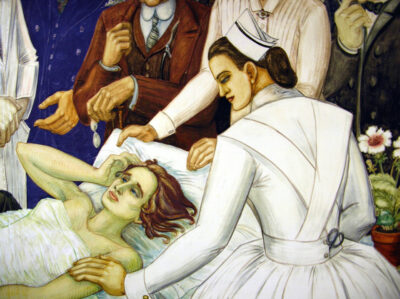
She would acknowledge later in life that she had no regrets, and she went on to use her nursing experience in her art, including her large-scale public murals, “The Life of a Nurse” (1953), and “The Advance of Neurology” (1954), now at the Montreal Neurological Institute at McGill.
She went on to teach art in post-secondary institutions in both Canada and the US, but in 1956 moved to England to escape an abusive marriage and live with her brother and his family while pursuing her artistic interests, including glasswork.

Filer was forty-nine when she settled in Victoria in 1969 with Harold Spence-Sales, a retired professor of architecture from McGill University whom she later married. By this time, influenced by the glass art movement of the 1960s, she was creating laminated glass art in the form of ambitious sculptures and layered murals.
Filer’s Victoria studio was filled with “acrylics, gold leaf, foils, clear and coloured glass and especially her dazzling sculptures,” according to Johnson-Dean, who notes that her work with glass “emphasized her attachment to the sea, particularly the Pacific Ocean, but her attention to light was constant.”
Filer’s glasswork was modernistic, employing geometric designs and vivid colours inspired by the natural beauty around Victoria. “I love the moods of seasons,” she wrote, “the drama of high slip-stream winds, great land promontories, and the ocean. Colours are iridescent — sometimes subtle, sometimes vulgar as moisture diffuses the brilliant light.”
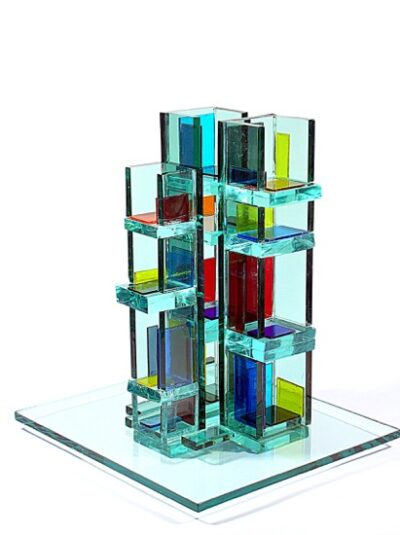
Commissions for church windows and glass sculpture installations continued after she and her husband moved to Vancouver in 1977. She and Spence-Sales renovated a 6,000 square foot box-shaped Purdy’s chocolate factory situated on the Fairview Slopes into a charming home and studio. Likeminded friends, artists and architects, enjoyed cocktails, conversation, and an expansive view of the city from their “salon.”
It was a creative time for Harold Spence-Sales, too, who designed the adjacent “Choklit Park,” a small public square with a view of the city skyline and North Shore Mountains.
In 1982, Filer exhibited “Circumferential Geometries” along with nineteen other glass artists. Her series of glass sculptures containing circles and semi-circles deals with ideas about the cycle of life and death. “My concern with sculpture is spatial,” Filer said in a talk. “I’m not blowing glass, I’m building with glass.”
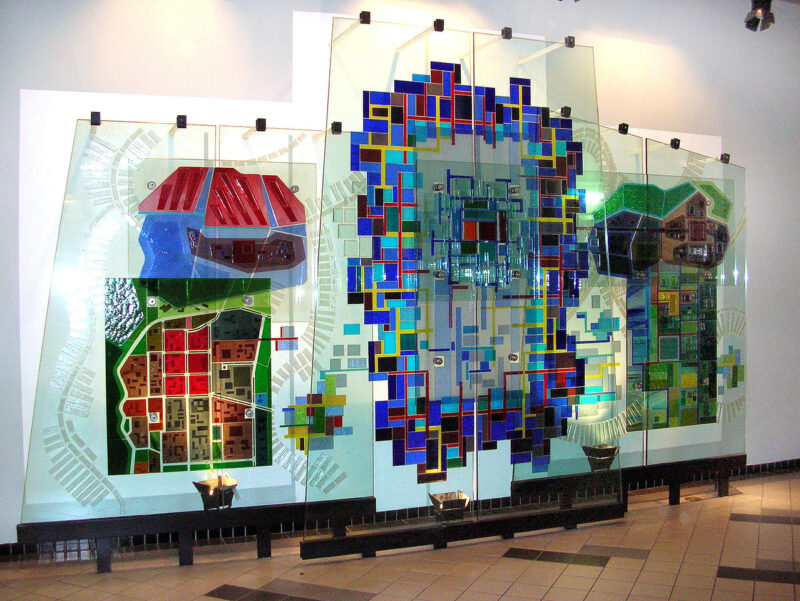

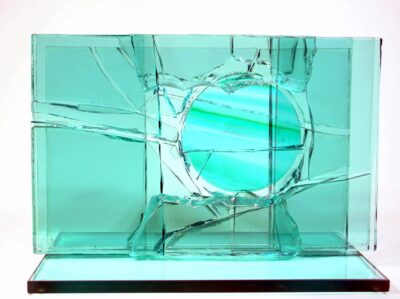
Filer was among the vanguard of glass artists to work collaboratively with architects, and international commissions and educational travel kept the couple moving through the 1980s. In 1990, her work found a permanent home in Vancouver at the concourse entrance to SFU’s downtown campus. Johnson-Dean notes that this stunning work, an untitled glass sculpture composed of three colourful panels, provides a “visual allegory about the energy and influences of the university upon the city’s centre, with mountains in the background.”
The strength of The Life and Art of Mary Filer lies in Johnson-Dean’s detailed account of Filer’s courageous ascendency in to the twentieth century art world. She explores Filer’s thoughts and emotions as she navigated parental pressures, gender stereotypes, and a debilitating first marriage.

Filer’s internal journey is less well documented for her personal life while living in England. I was left wondering what sustained her before returning to Canada, where she would enjoy wedded bliss with her husband up to his death in 2004? To what extent were her internal struggles reflected in her art?
Filer received several honours from Canadian universities and art institutes in her later years and her work is in the permanent collections of several galleries. Thankfully, to many she is a “heralded” artist, perhaps not fully fitting the theme of the publishers’ series.
Most importantly, The Life and Art of Mary Filer documents and portrays Filer’s extensive contributions and allows the reader to follow and appreciate the challenging and ultimately joyful artistic path she journeyed.
*
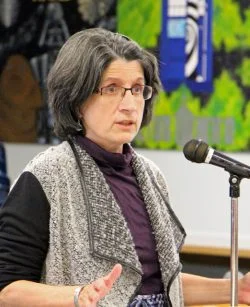
Janet Mary Nicol is a secondary school history teacher in Vancouver and a freelance writer. She has written local histories about Vancouver and its people for BC History, Canada’s History, Labour/Le Travail. Her latest article, “Bob Bouchette: Everyman Scribe,” was published in The Ormsby Review 30 (October 21, 2016). She also volunteers with the BC Labour Heritage Centre. Visit her writing blog here.
*
The Ormsby Review. More Books. More Reviews. More Often.
Publisher and Editor: Richard Mackie
The Ormsby Review is a journal service for in-depth coverage of B.C. books and authors. The Advisory Board consists of Jean Barman, Wade Davis, Robin Fisher, Cole Harris, Hugh Johnston, Patricia Roy, David Stouck, Maria Tippett, and Graeme Wynn. Scholarly Patron: SFU Graduate Liberal Studies. Honorary Patron: Yosef Wosk. Provincial Government Patron since September 2018: Creative BC
“Only connect.” – E.M. Forster
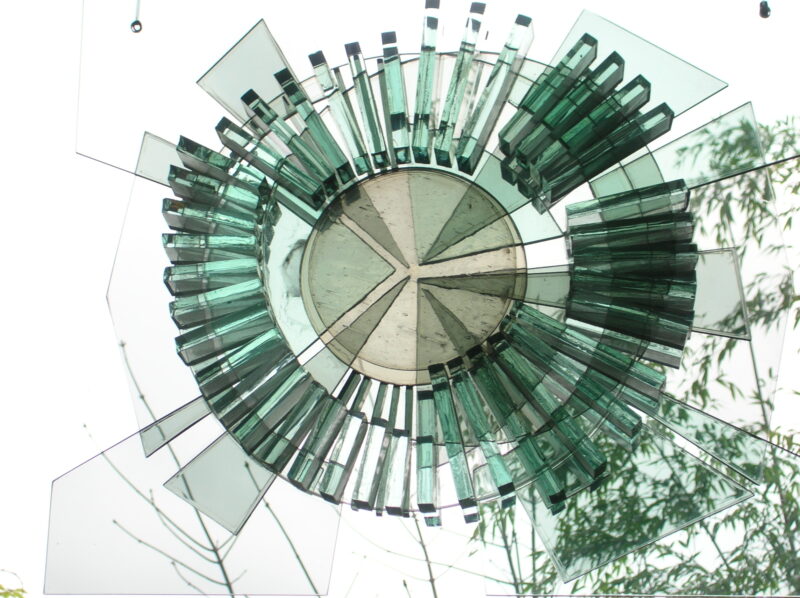































Comments are closed.